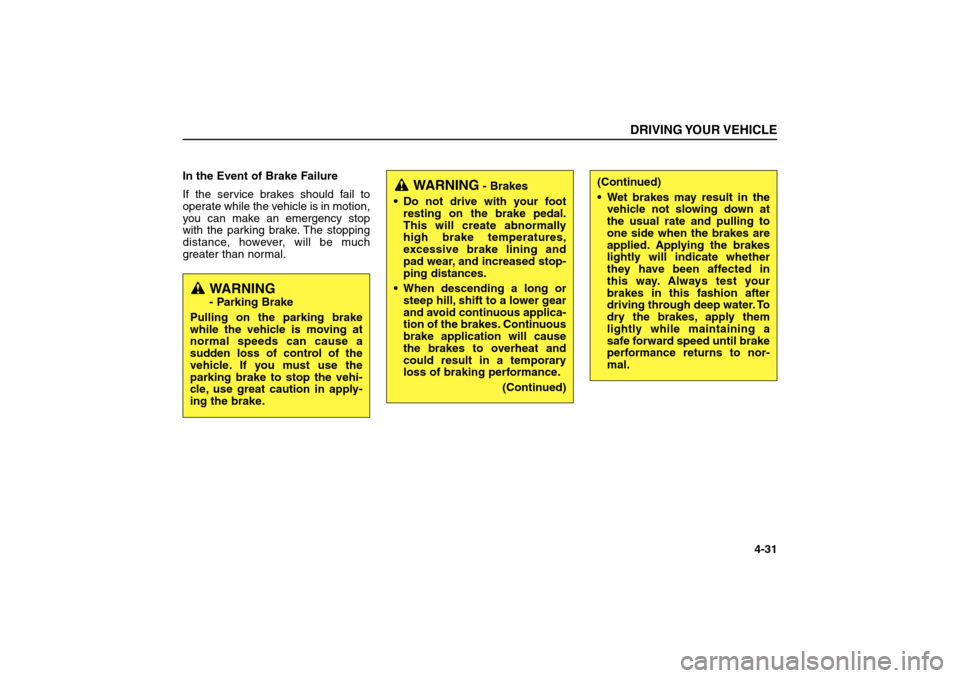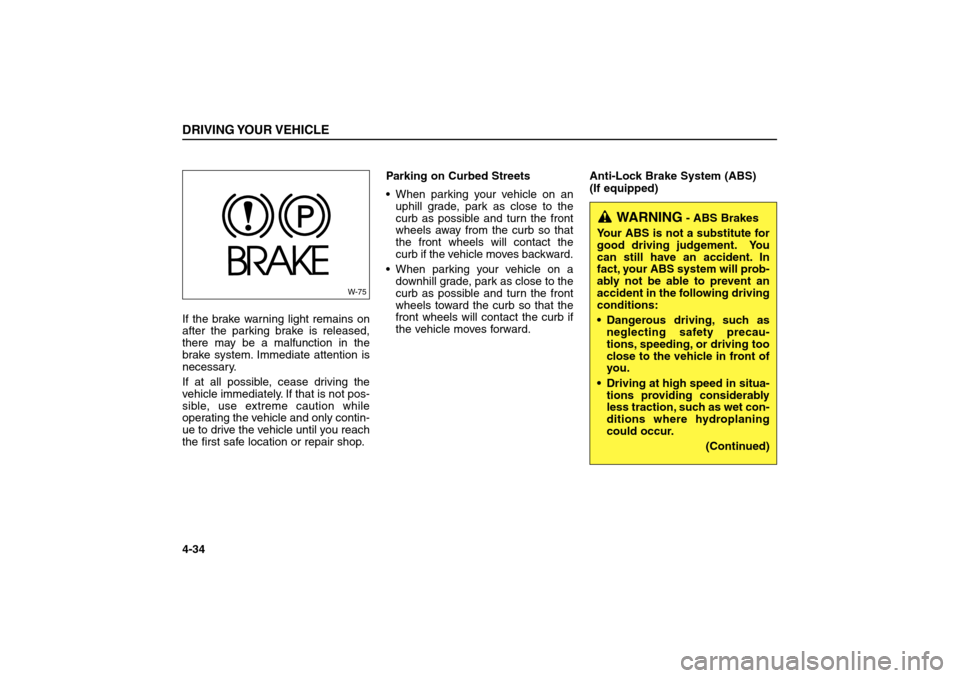2006 KIA Sorento brake
[x] Cancel search: brakePage 119 of 312

Always hold the steering wheel
firmly when you are driving off-
road.
Make sure all passengers are
wearing seat belts.
Do not drive in water if the level is
higher than the bottom of the vehi-
cle.
Check your brake condition once
you are out of mud or water. Press
the brake pedal several times as
you move slowly until you feel nor-
mal braking forces return.
Shorten your scheduled mainte-
nance interval if you drive in off-road
conditions such as sand, mud or
water (see “Scheduled Maintenance”
in the Index). Always wash you car
thoroughly.
DRIVING YOUR VEHICLE
4-21
WARNING
Reduce speed when you turn
corners. The center of gravity of
4WD vehicles is higher than
that of conventional 2WD vehi-
cles, making them more likely to
roll over when you turn corners
too fast.
CAUTION
If you are driving in heavy wind,
the vehicle's higher center of
gravity decreases your steering
control capacity and requires
you to drive more slowly.
WARNING
If you are driving too fast in
water, the water spray can get
into the engine compartment
and wet the ignition system,
causing your vehicle a sudden
stop. If this happens and your
vehicle is in a tilted position,
your vehicle may roll over.
BL-ENG (CAN)-4.qxd 7/28/05 5:55 PM Page 21
Page 126 of 312

Do not drive in water if the level is
higher than the bottom of the wheel
hubs.
Check your brake condition once
you are out of mud or water. Press
the brake pedal several times as
you move slowly until you feel nor-
mal braking forces return.
Shorten your scheduled mainte-
nance interval if you drive off-road in
conditions such as sand, mud or
water (see “Scheduled Maintenance’’
in the Index). Always wash your car
thoroughly.
The full time four wheel drive vehi-
cle cannot be towed by an ordinari-
ly tow truck. Make sure that the
vehicle is towed with its four wheels
raised off the ground.Since the driving torque is always
applied to the 4 wheels the perform-
ance of the 4WD vehicle is greatly
affected by the condition of the tires.
Be sure to equip them with all four
tires with same size and type.DRIVING YOUR VEHICLE4-28
CAUTION
While the full-time 4WD vehicle
is being raised on a jack, never
start the engine or cause the
tires to rotate.
There is the danger that rotating
tires touching the ground could
cause the vehicle to go off the
jack and to jump forward.
If one of the front or rear wheels
begins to spin in mud, snow,
etc. the vehicle can sometimes
be driven out by depressing the
accelerator pedal further; how-
ever avoid running the engine
continuously at high rpm
because doing so could dam-
age the 4WD system.
WARNING
-Driving Through Water
If you are driving too fast in
water, the water spray can get
into the engine compartment
and wet the ignition system,
causing your vehicle to sudden-
ly stop. If this happens and your
vehicle is in a tilted position,
your vehicle may roll over.
WARNING
Your vehicle is equipped with
tires designed to provide for safe
ride and handling capability. Do
not use a size and type of tire
and wheel that is different from
the one that is originally
installed on your vehicle. It can
affect the safety and perform-
ance of your vehicle, which
could lead to handling failure or
rollover and serious injury.
When replacing the tires, be
sure to equip all four tires with
the tire and wheel of the same
size, type, tread, brand and
load-carrying capacity. If you
nevertheless decide to equip
your vehicle with any tire/wheel
combination not recommended
by Kia for off road driving, you
should not use these tires for
highway driving.
BL-ENG (CAN)-4.qxd 7/28/05 5:55 PM Page 28
Page 128 of 312

LIMITED SLIP DIFFERENTIAL
(IF EQUIPPED) A limited slip differential if equipped,
is for the rear wheel differential only.
The features of this limited slip differ-
ential are described below;
Just as with conventional differential,
the wheel on one side is allowed to
turn at a different speed from the
wheel on the other side when the
vehicle is cornering.
The difference between the limited
slip differential and a conventional
differential is that if the wheel on one
side of the vehicle loses traction, a
greater amount of torque is applied to
the rear wheel on the other side to
improve traction.
BRAKE SYSTEMPower Brakes
Your vehicle has power-assisted
brakes that adjust automatically
through normal usage.
In the event that the power-assisted
brakes lose power because of a
stalled engine or some other reason,
you can still stop your vehicle by
applying greater force to the brake
pedal than you normally would. The
stopping distance, however, will be
longer. Refer to the scheduled main-
tenance guide for scheduled mainte-
nance intervals.
When the engine is not running, the
reserve brake power is partially
depleted each time the brake pedal is
applied. Do not pump the brake pedal
when the power assist has been
interrupted. Pump the brake pedal
only when necessary to maintain
steering control on slippery surfaces.
DRIVING YOUR VEHICLE4-30
WARNING
To avoid injury, never run the
engine with one wheel off the
ground, such as when changing
a tire.
BL-ENG (CAN)-4.qxd 7/28/05 5:55 PM Page 30
Page 129 of 312

In the Event of Brake Failure
If the service brakes should fail to
operate while the vehicle is in motion,
you can make an emergency stop
with the parking brake. The stopping
distance, however, will be much
greater than normal.
DRIVING YOUR VEHICLE
4-31
WARNING- Parking Brake
Pulling on the parking brake
while the vehicle is moving at
normal speeds can cause a
sudden loss of control of the
vehicle. If you must use the
parking brake to stop the vehi-
cle, use great caution in apply-
ing the brake.
WARNING
- Brakes
Do not drive with your foot
resting on the brake pedal.
This will create abnormally
high brake temperatures,
excessive brake lining and
pad wear, and increased stop-
ping distances.
When descending a long or
steep hill, shift to a lower gear
and avoid continuous applica-
tion of the brakes. Continuous
brake application will cause
the brakes to overheat and
could result in a temporary
loss of braking performance.
(Continued)
(Continued)
Wet brakes may result in the
vehicle not slowing down at
the usual rate and pulling to
one side when the brakes are
applied. Applying the brakes
lightly will indicate whether
they have been affected in
this way. Always test your
brakes in this fashion after
driving through deep water. To
dry the brakes, apply them
lightly while maintaining a
safe forward speed until brake
performance returns to nor-
mal.
BL-ENG (CAN)-4.qxd 7/28/05 5:55 PM Page 31
Page 130 of 312

Disc Brake Wear Indicators
Your vehicle has disc brakes.
When your brake pads are worn and
it’s time for new pads, you will hear a
high-pitched warning sound from
your front brakes. You may hear this
sound come and go or it may occur
whenever you depress the brake
pedal.
Please remember that some driving
conditions or climates may cause a
brake squeal when you first apply (or
lightly apply) the brakes. This is nor-
mal and does not indicate a problem
with your brakes.Parking Brake
To set the parking brake, pull the
parking brake handle fully and firmly
upward while applying the service
brake.DRIVING YOUR VEHICLE4-32
S2BLC302B
WARNING
- Brake Wear
This brake wear warning sound
means your vehicle needs serv-
ice. If you ignore this audible
warning, you will eventually
lose braking performance,
which could lead to a serious
accident.
✽ ✽
NOTICETo avoid costly brake repairs, do
not continue to drive with worn
brake pads. Always replace brake
pads or linings as a complete front
or rear axle sets.
CAUTION
Always replace brake pads as
complete front or rear axle sets.
BL-ENG (CAN)-4.qxd 7/28/05 5:55 PM Page 32
Page 131 of 312

To release the parking brake, pull the
handle up slightly and push the
release button. Then lower the handle
to the released position while holding
the button in.Check the brake warning light each
time you start the engine. This warn-
ing will be illuminated when the
engine is running and the parking
brake is set.
Before driving, be sure the parking
brake is fully released and the brake
warning light is off.
DRIVING YOUR VEHICLE
4-33
S2BLC302C
WARNING
To prevent unintentional move-
ment when stopped and leaving
the vehicle, do not use the
gearshift lever in place of the
parking brake. Set the parking
brake AND make sure the
gearshift lever is securely posi-
tioned in 1st (First) gear or R
(Reverse) for manual transmis-
sion equipped vehicles and in P
(Park) for automatic transmis-
sion equipped vehicles.
BL-ENG (CAN)-4.qxd 7/28/05 5:55 PM Page 33
Page 132 of 312

If the brake warning light remains on
after the parking brake is released,
there may be a malfunction in the
brake system. Immediate attention is
necessary.
If at all possible, cease driving the
vehicle immediately. If that is not pos-
sible, use extreme caution while
operating the vehicle and only contin-
ue to drive the vehicle until you reach
the first safe location or repair shop.Parking on Curbed Streets
When parking your vehicle on an
uphill grade, park as close to the
curb as possible and turn the front
wheels away from the curb so that
the front wheels will contact the
curb if the vehicle moves backward.
When parking your vehicle on a
downhill grade, park as close to the
curb as possible and turn the front
wheels toward the curb so that the
front wheels will contact the curb if
the vehicle moves forward.Anti-Lock Brake System (ABS)
(If equipped)DRIVING YOUR VEHICLE4-34
WARNING
- ABS Brakes
Your ABS is not a substitute for
good driving judgement. You
can still have an accident. In
fact, your ABS system will prob-
ably not be able to prevent an
accident in the following driving
conditions:
Dangerous driving, such as
neglecting safety precau-
tions, speeding, or driving too
close to the vehicle in front of
you.
Driving at high speed in situa-
tions providing considerably
less traction, such as wet con-
ditions where hydroplaning
could occur.
(Continued)
W-75
BL-ENG (CAN)-4.qxd 7/28/05 5:55 PM Page 34
Page 133 of 312

The ABS system continuously sens-
es the speed of the wheels. If the
wheels are going to lock, the ABS
system repeatedly modulates the
hydraulic brake pressure to the
wheels.
When you apply your brakes under
conditions which may lock the
wheels, you may hear a “tik-tik’’
sound from the brakes, or feel a cor-
responding sensation in the brake
pedal. This is normal and it means
your ABS system is active.
In order to obtain the maximum ben-
efit from your ABS system in an
emergency situation, do not attempt
to modulate your brake pressure and
do not try to pump your brakes. Press
your brake pedal as hard as possible
or as hard as the situation warrants
and allow the ABS system to control
the force being delivered to the rear
brakes.Even with the anti-lock brake sys-
tem, your vehicle still requires suffi-
cient stopping distance. Always
maintain a safe distance from the
vehicle in front of you.
Always slow down when cornering.
The anti-lock brake system cannot
prevent accidents resulting from
excessive speeds.
On loose or uneven road surfaces,
operation of the anti-lock brake sys-
tem may result in a longer stopping
distance than for vehicles equipped
with a conventional brake system.
DRIVING YOUR VEHICLE
4-35
ABS
W-78
(Continued)
Driving too fast on poor road
surfaces. The ABS is
designed to improve maxi-
mum braking effectiveness on
typical highways and roads in
good condition. On poor road
surfaces in poor condition,
the ABS may actually reduce
braking effectiveness.
BL-ENG (CAN)-4.qxd 7/28/05 5:55 PM Page 35